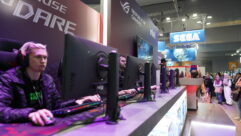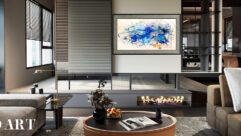

Immersive Picture and Sound: Products
Dec 29, 2014 11:26 AM
Green Hippo Par4Keet
Par4Keet by Green Hippo combines video playback at 4K resolution with realtime media manipulation and multiscreen configurability over standard display cabling. The flagship player in the company’s AViary range, Par4Keet utilizes Green Hippo’s BirdKeeper remote networking software for total configuration and control from any networked PC for all key functions and for live operation. The player can deliver media at arbitrary resolutions, while logo overlay, in/out points, and optional integration with protocols such as SMPTE, MIDI and DMX can be deployed and programmed from within the unit’s user interface. Par4Keet’s features a 3U rackmount chassis, designed with hands-on use as a priority. An array of removable media drives allows content management from the front panel while a touchscreen interface gives instant access to all priority functions. A professional grade jog-shuttle and clearly labeled transport buttons makes Par4Keet ideal for corporate events AV rental applications.

Christie Vive Audio
Christie Vive Audio loudspeaker solution comprises surround and screen channel speakers, subwoofers, and Class D amplifiers to deliver an immersive cinema experience. At the core of the system are screen channel speakers with ribbon driver technology and a line array speaker design, all in a single enclosure— a design that the company says helps to increase the optimal listening area up to four times when compared to conventional compression driver-based audio systems. Christie Vive Audio’s line of cinema-specific audio technologies are designed to support leading cinema audio formats including Dolby Atmos, 7.1 and 5.1 surround sound and Auro 11.1.

Meyer Sound HMS-15
Meyer Sound’s self-powered HMS-15 surround loudspeaker is designed for high-power, longer-throw applications in cinema exhibition auditoriums as well as in post-production and screening rooms and is ideally suited for the extreme demands of immersive formats such as Dolby Atmos and Barco Auro. The HMS-15 houses a 15in. long-excursion LF driver; a 3in. diaphragm HF compression driver coupled to a consistent 80-degree H x 50-degree V horn; and two-channel amplification with active crossover, driver protection, and correction for phase and frequency response with a resultant frequency range of 50Hz to 18kHz and a maximum peak SPL of 133dB (@ 1m) with very low distortion. The HMS 15 can be mounted on walls or ceilings at fixed or adjustable angles with the optional wall-mount brackets or U-bracket. The speaker is available in two models: the 48 V DC version, HMS-15, is powered by the MPS-488HP external power supply, which eliminates the need for wiring conduits and the HMS-15AC model, which is ideal for installations where AC power is readily available. The HMS-15 joins a full line of Meyer Sound cinema surround loudspeakers that also comprises, in descending size, the HMS-12, HMS-10, and HMS-5.
Immersive Picture and Sound: Products
Dec 29, 2014 11:26 AM


Christie’s three upgraded versions of its Twist technology deliver full image warping and advanced edge blending in Christie 3-chip DLP projectors using software that controls and edge-blends multiple curved images seamlessly on any surface. Said to be easier to use and with better, more precise pixel-to-pixel alignment than ever, the upgraded Christie Twist product family includes three tiers of specialized Twist software each for different application requirements. ‘Christie Twist’ software is a free download from the Christie website. ‘Christie Twist Premium’ and ‘Christie Twist Pro’ are paid upgrades and provide additional functionality for more complex projects. Christie Twist and Christie Twist Premium are ideal for a wide range of applications including live theater and events, projection mapping, tradeshows, and large classrooms. For more intricate projects, including flight simulators, virtual caves, and domes, Christie Twist Pro delivers unlimited arbitrary placement points for even greater accuracy. Christie Twist technology also provides networked projector control by allowing the user to launch a virtual remote from within the twist software with all the functionality of standard Infrared remotes.
BARCO/AURO/IOSONO
In part because of the relationship between the pioneering audio company Auro Technologies and projection heavyweight Barco, the Auro-3D format, specifically its Auro 11.1 configuration, is familiar to many in our industry, at least by name. Auro-3D uniquely adds the dimension of height in order to emulate the three-dimensionality of natural sound (this characteristic of immersion is present in the Auro formats irrespective of the use of object- or channel-based technology).
Barco is a minority shareholder in Auro Technologies and the two companies have a contractual relationship for their digital cinema market solutions. However, the possibilities of Auro-3D format extend beyond cinema, with implications for games, music, cars, mobile as well as the immersive home entertainment and ProAV industries.
In late September, Barco announced the purchase of the sound company IOSONO. This will broaden the Barco and Auro-3D audio offering in two ways. First, IOSONO brings hardware rendering technology that will enable playback of the existing object-based features in the Auro-3D Creative Tool Suite plugin software. “With the object-based approach, in combination with our three-layered speaker layouts, we achieve the highest spatial resolution immersive sound system on the market, called Auro-Max,” claims Wilfried Van Balen, the inventor of Auro 3D tand CEO of Auro Technologies.
Object-based audio trends are increasingly dynamic, especially with the upcoming SMPTE object-based standard in the works. It is important to note that the SMPTE standard is not a standard about the immersive sound format. It is a standard for a common delivery format for object-based assets. This is a key distinction because it leaves the field open to innovation; companies will continue to develop differentiating guest experiences and systems, based on a common language for the authoring process of object-based assets.
“The Auro-3D format was always conceived for object-based upgrades,” says Van Balen. “We believe that up to about 15 channels, that our channel-based approach is the most efficient choice to deliver a true 3D space to listeners in all markets. Once you have at least 20 individual amplified channels, it make sense to go further by adding object-based, and that’s what the Auro-Max format is designed to do.”
In addition to bringing rendering hardware for digital cinema applications, IOSONO software also brings new options to planetariums, theme parks, museums, visitors’ centers, and performing arts centers. Already IOSONO has enlivened the Sydney Opera House as well as immersive installations for artists such Robert Wilson and others. With both the Auro-3D and IOSONO technologies, Barco seems poised to compete and influence the next wave of immersive and spatial audio.
Overall, AV designers can take advantage of developments from the cinema market, while also having additional options to choose from that do not have to be DCI compliant. Whether clients will benefit from a channel-based or object-based design, and which of the object-based options best suits the environment, is an important discussion in our industry where spaces are often nonstandard as compared to a multi-plex cinema.
Depending on the shape of the room, the zoning, the nature of the content, and the client budget, there are new options to consider in delivering the optimal guest experience.









